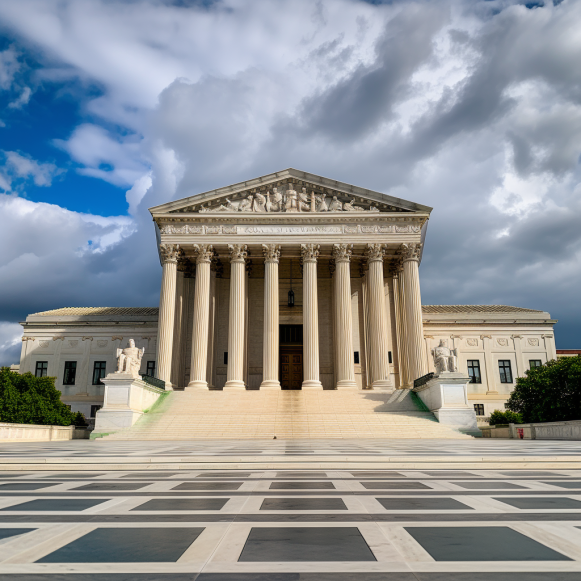It may have just gotten harder to protect minority communities from pollution

Can state lawmakers remedy environmental racism without mentioning race?
In recent years, some states have increased their investment in air quality monitoring, scrutinized permitting decisions, and directed cleanup funds to minority communities that have borne the brunt of pollution for decades.
Following the recent decision by the United States Supreme Court to overturn race-conscious college admissions policies, state legislators are faced with a new conundrum: Can they address environmental racism without mentioning race?
“The [Supreme Court] majority really reinforced the idea that a generalized government policy of rectifying past discrimination would not pass constitutional muster,” said Emily Hammond, an environmental law expert and law professor at George Washington University.
The ruling has lawmakers scrambling to figure out what it means for their environmental justice efforts. Legislators in some states expect lawsuits to jeopardize their policies. The question is whether they can defend those measures in court, or if they must revise the laws to ensure they are not overturned.
As a result of these factors, studies show that communities of color face disproportionate levels of air and water pollution, less access to green space, and significant health disparities. Highways, refineries, fossil fuel plants, and waste dumps are frequently carved into such communities.
“We want to acknowledge the harms we have done as a state with our environmental laws, permitting, waste and pollution, and reduce the harms to communities that have been impacted more, which are historically communities of color,” Minnesota state Rep. Fue Lee said.
The Democrat was a key supporter of a law that was passed this year that requires regulators to consider cumulative pollution effects before issuing air quality permits in certain areas, such as tracts with 40% or more nonwhite residents. However, he acknowledged that lawmakers should be prepared to revise those criteria if the law is challenged in court.
“If we don’t want to use race, we can use proxies like health conditions,” he explained. “My district has one of the highest rates of hospitalization for asthma and heart disease.” Those are some potential next steps; we just need to be inventive.”
The Supreme Court ruled in June that colleges could no longer use race as an admissions factor. The majority found that policies that favor minority applicants violate the equal protection clause of the Constitution in a 6-3 decision.
Legal experts are concerned that this will pave the way for lawsuits challenging other race-conscious policies, such as many state-level efforts to address environmental justice. These legal battles have the potential to stymie investments to help polluted communities.
“It is not that defending race-conscious measures is impossible; it is that doing so is expensive and time-consuming, as well as unlikely to persuade judges convinced that use of race is always pernicious,” Toni Massaro, a constitutional law scholar at the University of Arizona, wrote in an email to Stateline.
Many state legislators have stated that they are still deciding how to proceed.
“I share deep concerns about how this ruling will impact our environmental justice laws,” said Washington state Rep. Debra Lekanoff, a Democrat who was a key supporter of the state’s cap-and-trade program, which auctions pollution allowances for carbon emissions and redirects the proceeds to clean energy and climate adaptation projects.
The package also includes increased air quality monitoring and revenue distribution to “overburdened” communities. To identify those areas, the state includes racial or ethnic minority populations among its criteria.
Even if the program faces legal challenges, other factors included in the analysis, such as pollution exposure and health effects, may still serve to direct resources to communities affected by environmental racism, according to Lekanoff.
“The science will tell us that the people who are dying as a result of environmental degradation are in communities of color,” she predicted. “Whether or not [race] is in the law, if you look with wide eyes at who has suffered the most negative consequences, the truth will emerge.”
Lekanoff stated that she and other legislators will consult with Democratic Attorney General Bob Ferguson to determine whether the law should be revised or a lawsuit filed.
The Biden administration established the Climate and Economic Justice Screening Tool, a “race-neutral” screening methodology, to guide its efforts to direct 40% of federal spending across many agencies to disadvantaged communities. The tool takes into account nearly two dozen environmental and economic factors, but excludes race. Environmental justice advocates claim that the White House did this to protect the program from legal challenges.
According to a Grist analysis, the Biden administration’s funding categories, which included income, climate vulnerability, health, housing, and legacy pollution, primarily targeted communities of color.
“A breakdown of all U.S. census tracts shows that, as the number of non-white residents in a tract increases, the tract becomes more likely to be considered disadvantaged by the White House tool,” according to the analysis.
Despite the legal ambiguity, some environmental justice advocates urged lawmakers not to ignore race. Robert Bullard, a civil rights activist and Texas Southern University professor, has been dubbed the “Father of the Environmental Justice Movement.” He cited federal statutes that take race into account, such as the Fair Housing Act and the Voting Rights Act.
“If we were so fearful, shy, and threatened by the Supreme Court coming in and throwing out everything,” he said, “we’d still be picking cotton in 2023.” “We must fight back against policies that are destroying our communities.” If lawsuits arise as a result of our efforts to eradicate racism, they should not intimidate us into fighting for our basic rights.”
States concerned about legal challenges, according to Bullard, could draft provisions similar to the White House tool, but he urged them to cross-reference other screening methods to determine if communities of color are being excluded. Other tools, such as the California regulators’ program, take into account the cumulative effects of the health and environmental factors that each community faces.
Some lawmakers agreed with Bullard’s call for bravery.
“The important thing is not to concede that our policymaking should obviously change,” said Laurie Pohutsky, a Democrat and House speaker pro tempore from Michigan. “If a problem arises, we will deal with it as it arises.” We are in the business of making good policy, not capitulating to an unelected extremist body.”
Pohutsky has proposed legislation that would require utility regulators to minimize harm and prioritize benefits for minority and low-income communities. The measure is part of a larger renewable energy package. Lawmakers will also consider a Senate bill that would direct a portion of polluters’ fines to “environmental protection communities,” as identified by a federal screening tool that takes race into account.
Pohutsky expressed confidence that those efforts, which took into account many factors other than race, would withstand legal challenges.
According to Hammond, the legal scholar, race-based policies that govern regulatory actions such as permitting decisions may be on more solid legal ground than those that govern funding. According to Hammond, the distribution of benefits based on race will be scrutinized more closely. Meanwhile, the Supreme Court’s decision earlier this year to uphold the Indian Child Welfare Act may protect tribal community policies, ensuring their status as sovereign political entities rather than racial groups.
Severability clauses are one option for lawmakers, according to Hammond. Such measures could allow them to continue using race in their analysis while also allowing the laws to revert to something like the federal tool if race-based metrics are deemed invalid by a court.
“There’s a lot in [state environmental justice laws] that should be fine, and there are perhaps pieces that present heightened risk,” Hammond said.






